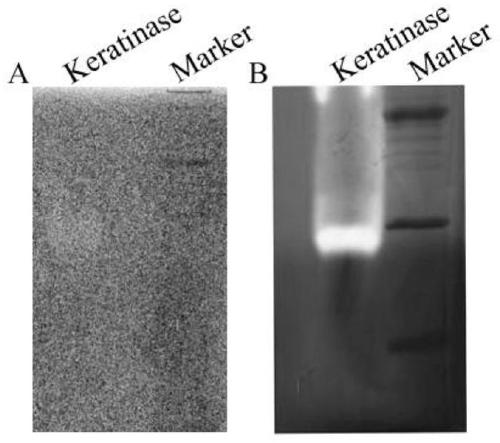Zymogram technique for detecting enzymatic activity of keratin
A technology of protease and keratin, which is applied in biochemical equipment and methods, measuring devices, and microbial determination/inspection, etc., can solve the problems of low sensitivity, low substrate specificity, and low discrimination of hydrolyzed bands, and achieve identification Strong, easy to distinguish, improve the effect of discrimination and sensitivity
- Summary
- Abstract
- Description
- Claims
- Application Information
AI Technical Summary
Problems solved by technology
Method used
Image
Examples
Embodiment 1
[0040] 1. Keratin substrate pretreatment
[0041] (1) Cooking
[0042] Add 10g of feathers and 500ml of dimethyl sulfoxide or ethylene glycol into the reflux condensing device, and digest at 80-100°C for 60-100min. Then, feather keratin was precipitated with twice the volume of acetone pre-cooled at 4°C.
[0043] (2) Wash and dry
[0044] Centrifuge to collect keratin precipitate, 2000g / 15min. Resuspend with deionized water, wash the precipitate, collect the precipitate by centrifugation at 2000g / 15min, repeat the washing once, and then dry it at 4°C.
[0045] (3) Grinding and sieving
[0046] After the keratin is ground, pass through a 100-mesh sieve to obtain a keratin powder base, which is divided into equipment for use.
[0047] 2. Preparation of Keratinase Gel Spectra
[0048] (1) Preparation of separating gel (containing 0.1% pretreated keratin substrate, here 10ml separating gel is used as standard description)
[0049] According to the standards described in the...
experiment example 1
[0070] Adopt the zymography method described in Example 1 and the traditional zymography method of "Molecular Cloning Experiment Guide" described in Comparative Example 1 to carry out zymography detection (keratin-degrading bacterial strain) to the K.paraultunense anaerobic bacteria keratinase after chromatographic purification K.paraultunense was purchased from Tianjin Xima Technology Co., Ltd.), and the discrimination and sensitivity of the two methods were compared. The anaerobic bacteria K.paraultunense was inoculated at 5%-10% (v / v) in the fermentation medium containing 1% (w / v) feather substrate. Then, culture them at 55°C for 24-48 hours until the feathers are completely degraded. The supernatant of the fermentation broth was collected and centrifuged at 12000rpm for 30min. Next, the supernatant was filtered through a 0.22 μm membrane to remove bacteria to obtain a crude enzyme solution. The crude enzyme liquid samples were concentrated in a hollow fiber column and se...
experiment example 2
[0072] Experimental example 2 Zymogram detects the influence of different protease inhibitors on K bacteria keratinase
[0073] In order to further confirm the enzymatic characteristics of K.paraultunense anaerobic keratinase, K.paraultunense anaerobic keratinase was treated with different protease inhibitors. The fermentation and purification steps are the same as the above experimental example 1. After the fermentation broth is purified, take 5-10 μl of keratinase sample, mix it with loading buffer in a ratio of 1:3, and use the method described in Example 1 to perform keratinase zymogram detection . Among them, during the color development process of the hydrolysis band, four common protease inhibitors were added to the incubation solution during the incubation stage: 10 mM serine protease inhibitor-phenylmethylsulfonylfluoride (Phenylmethanesulfonylfluoride, PMSF); 10 μM aspartic protease Inhibitor-pepstatin (pepstatinA); 10 uM cysteine protease inhibitor E-64; 10 mM me...
PUM
 Login to View More
Login to View More Abstract
Description
Claims
Application Information
 Login to View More
Login to View More - R&D
- Intellectual Property
- Life Sciences
- Materials
- Tech Scout
- Unparalleled Data Quality
- Higher Quality Content
- 60% Fewer Hallucinations
Browse by: Latest US Patents, China's latest patents, Technical Efficacy Thesaurus, Application Domain, Technology Topic, Popular Technical Reports.
© 2025 PatSnap. All rights reserved.Legal|Privacy policy|Modern Slavery Act Transparency Statement|Sitemap|About US| Contact US: help@patsnap.com


